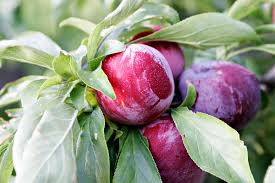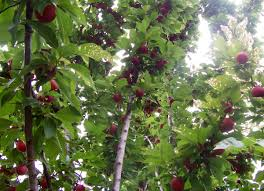Plum
Scientific Name: Prunus domestica
Climate: It prefers temperate climates, between 12 and 22 ° C, but also grows well in fairly cold climates, resisting frost. It can be grown up to altitudes of 700 m
Plant Description: It is a deciduous tree that reaches up to eight meters in height. Like most fruit trees, it can be kept shorter to facilitate harvesting. The trunk is blue-green and can be smooth or cracked. The flowers are white and the fruit is yellow or red.1
Cultivation: The plum can be reproduced from seed, cuttings and by grafting. It is easy to grow due to its resistance to cold. It grows best in full sun.
In winter, in areas with moderately frequent rains, watering will not be necessary. It prefers annual rainfall of 700 mm. In any case, if there is a dry period, it should be watered.
It adapts to all soils, except sandy ones. It can stand limestone, moisture and compact soil well. Due to its shallow root system, it tolerates humidity and can live in shallow soils better than other fruit trees.
Plums are ready to harvest when they give off a strong smell or when they easily drop from the tree if shaken.
 Uses: The plum can be eaten dried, preserved or fresh. It is a natural laxative and is recommended in cases of constipation. For lip ulcers, you can make plum juice, wet some cotton wool with the liquid and apply it on the ulcer. For the inside of the mouth, the juice of two fresh plums can be used and kept in the mouth applied with the affected parts. It is also commonly used to combat circulatory problems, such as high blood pressure, menopause and other metabolic disorders. The oil from its seed is used as food. It contains large amounts of vitamin C.
Uses: The plum can be eaten dried, preserved or fresh. It is a natural laxative and is recommended in cases of constipation. For lip ulcers, you can make plum juice, wet some cotton wool with the liquid and apply it on the ulcer. For the inside of the mouth, the juice of two fresh plums can be used and kept in the mouth applied with the affected parts. It is also commonly used to combat circulatory problems, such as high blood pressure, menopause and other metabolic disorders. The oil from its seed is used as food. It contains large amounts of vitamin C.
Pests and Diseases: Plum is susceptible to aphids, fruit flies, and mealy bugs. It is affected by gummosis as well. To avoid gummosis, it is important to ensure that the soil around the tree does not become muddy, use a good compost, and heal areas that have been pruned.
References:
- https://arbolesfrutales.org/ciruelo-todo-lo-que-debes-saber/
- http://agriculturers.com/el-cultivo-del-ciruelo/
En español: Ciruela

